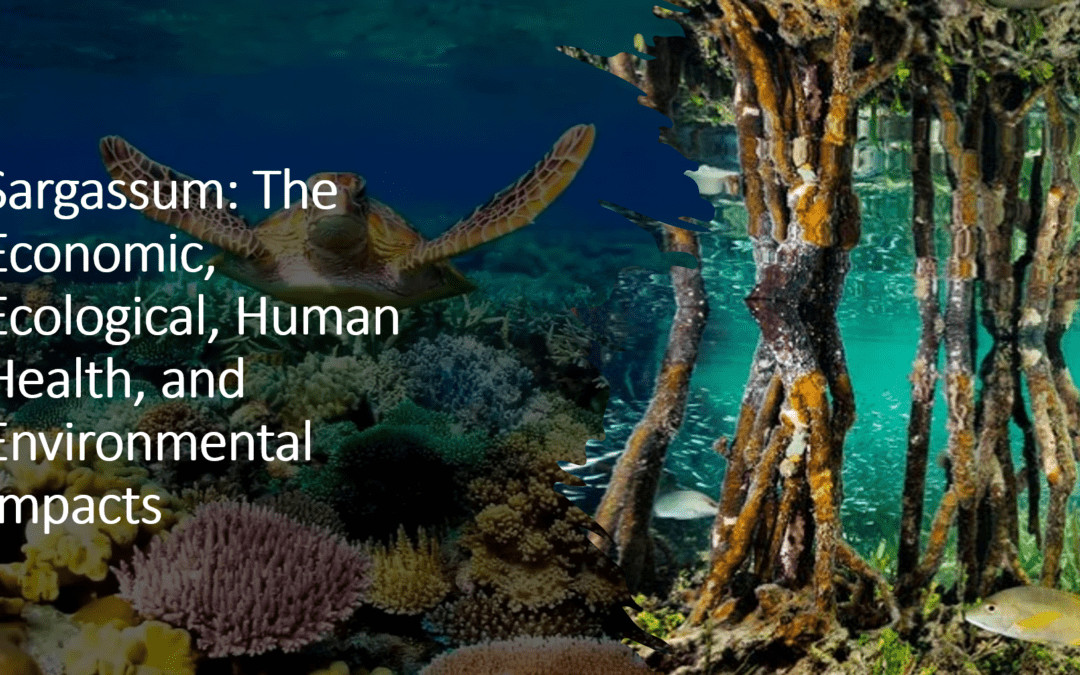Belize Delegation Research and Educational Visit to Variodin AG, Germany, 1st September to 2nd September 2022, Hamburg and Berlin, Germany
Sargassum: “The Golden Tide” Devastating the Caribbean Region: The Economic, Ecological, Human Health, and Environmental Impacts
Sargassum is not native to the Caribbean Sea. It is a genus of large brown seaweed (a type of algae) that floats in the ocean and never attaches to the sea floor.
Sargassum inhabits shallow water and coral reefs. It often causes a foul odor, releasing fumes of sulfur compounds that rust metals and damage modern conveniences. And it is now at record levels or nearly 25 million tonnes, blanketed on Caribbean coastlines and has threatened to impact key industries of the region negatively.
Fisherfolk have been heavily impacted, unable to retrieve nets, damaged to boat engines, and unable to leave the shore. An overabundance of sargassum is blamed for the recent deaths of thousands of fish across the Caribbean region.
Scaling back or cancellation of water activities (deep sea diving, kayaking, paddle boarding and snorkeling, water tours)
Scientists say the algal explosion in the Atlantic Ocean and Caribbean Sea could signify a new normal. Climate change, deforestation, and fertilizer use are among the factors thought to be driving the growth.
Electrical Generation in the Caribbean Region
Overall, more than half of the electric energy capacity of 10 of 13 CARICOM countries comes from diesel or oil; only Belize (hydroelectric), Suriname (hydroelectric), and Trinidad and Tobago (natural gas) generate a majority of their capacity from other sources.
In Belize, primary energy is found as combustible fuelwood, renewable generation sources: hydro, solar, and bagasse, alongside crude oil and natural gas from the Spanish Lookout and Never Delay oilfields. Collectively, the primary energy supply equated to 6,046 TJ.
Technological Solution In Ocean BioEnergy: Converting Sargassum to a Substitute Fuel
THERE ARE TWO MAIN SYSTEMS FOR CONVERTING CARBON-BASED WASTE INTO ENERGY SERVICES OR FUELS:
Thermal Conversion: For solid carbon materials such as wood, plastics, and paper.
- Gasification – in an environment of limited air – light combustible gas (CO, Hydrogen)
- Pyrolysis – in an environment of no air–pyrolysis gases, heavy molecule carbon compounds
Other.
Biological Conversion: For liquid effluents with high carbon content, distillery and brewery waste, dairy, domestic wastewater, abattoir waste, and fish and poultry offal.
- Anaerobic Fermentation – bacteria growth in a very low or oxygen-free environment producing methane and hydrogen sulfide.
Next Step: Development of a Pilot Project
Scale of Operations
The San Pedro and Caye Caulker islands are estimated to generate an estimated 10,000 tons of MSW annually. Based on an estimated 50 percent of the MSW as Carbon waste, about 5000 tons of refuse-derived solid fuel will be available for conversion into pellets for power generation.
The amount of processed Sargassum biomass that will be incorporated will be determined as part of the feasibility study, which will take into consideration the CAPEX and operating cost for the capture, initial dewater, and transportation to San Pedro for final processing and use.
Description of the Technology System
MSW processing to stable solid fuel
- Separation of combustible and non-combustible.
- Shredding of Combustible material into small pieces.
- Pelletizing into small beads.
Sargassum Biomass into stable solid fuel
- Biomass capture and initial dewatering after collection at sea.
- Transportation.
- Secondary drying using waste heat from the electricity plant.
- Shredding of biomass followed by pelletizing into small beads or baling into large rolls for longer-term storage, depending on the design choices and costs.
Electricity/Power Generation
MSW and Sargassum biomass-derived pellets are fed to Pyrolysis Unit, which converts them into a gas.
The gas leaving the Pyrolysis Unit goes into a diesel engine which is connected to an electricity generator, and power is produced and exported to the Grid.
Belize Cabinet Approves MOU
Belmopan, 13th October 2022. 4:00 p.m.
The Cabinet, chaired by Prime Minister Hon. John Briceño, met in regular session on 11th October 2022.
The Belize Cabinet approved signing a memorandum of understanding (MOU) between Belize and Variodin AG, a technology company based in Germany.
The MOU will set the conditions for capitalizing on and mitigating the growing threat of sargassum to the region’s critical tourism industry by using it to produce energy.
(END)
SIDS DOCK is a United Nations (UN)-recognised international organisation established in 2015, with all the rights and privileges for addressing climate change, resilience, and energy security in small islands. SIDS DOCK represents 32 small islands and low-lying developing states across the globe, and is so named because it is designed as a “DOCKing station,” to connect the energy sector in SIDS with the global markets for finance and sustainable energy technologies. The organisation’s work is coordinated by the Secretariat, in Belmopan, Belize.
CONTACT:
|
|
|

